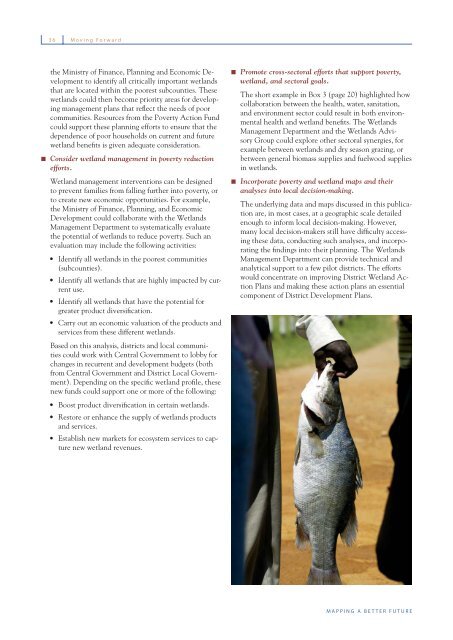Mapping a Better Future - World Resources Institute
Mapping a Better Future - World Resources Institute
Mapping a Better Future - World Resources Institute
Create successful ePaper yourself
Turn your PDF publications into a flip-book with our unique Google optimized e-Paper software.
36 Moving Forward<br />
the Ministry of Finance, Planning and Economic Development<br />
to identify all critically important wetlands<br />
that are located within the poorest subcounties. These<br />
wetlands could then become priority areas for developing<br />
management plans that refl ect the needs of poor<br />
communities. <strong>Resources</strong> from the Poverty Action Fund<br />
could support these planning efforts to ensure that the<br />
dependence of poor households on current and future<br />
wetland benefi ts is given adequate consideration.<br />
Consider wetland management in poverty reduction<br />
efforts.<br />
Wetland management interventions can be designed<br />
to prevent families from falling further into poverty, or<br />
to create new economic opportunities. For example,<br />
the Ministry of Finance, Planning, and Economic<br />
Development could collaborate with the Wetlands<br />
Management Department to systematically evaluate<br />
the potential of wetlands to reduce poverty. Such an<br />
evaluation may include the following activities:<br />
• Identify all wetlands in the poorest communities<br />
(subcounties).<br />
• Identify all wetlands that are highly impacted by current<br />
use.<br />
• Identify all wetlands that have the potential for<br />
greater product diversifi cation.<br />
• Carry out an economic valuation of the products and<br />
services from these different wetlands.<br />
Based on this analysis, districts and local communities<br />
could work with Central Government to lobby for<br />
changes in recurrent and development budgets (both<br />
from Central Government and District Local Government).<br />
Depending on the specifi c wetland profi le, these<br />
new funds could support one or more of the following:<br />
• Boost product diversifi cation in certain wetlands.<br />
• Restore or enhance the supply of wetlands products<br />
and services.<br />
• Establish new markets for ecosystem services to capture<br />
new wetland revenues.<br />
Promote cross-sectoral efforts that support poverty,<br />
wetland, and sectoral goals.<br />
The short example in Box 3 (page 20) highlighted how<br />
collaboration between the health, water, sanitation,<br />
and environment sector could result in both environmental<br />
health and wetland benefi ts. The Wetlands<br />
Management Department and the Wetlands Advisory<br />
Group could explore other sectoral synergies, for<br />
example between wetlands and dry season grazing, or<br />
between general biomass supplies and fuelwood supplies<br />
in wetlands.<br />
Incorporate poverty and wetland maps and their<br />
analyses into local decision-making.<br />
The underlying data and maps discussed in this publication<br />
are, in most cases, at a geographic scale detailed<br />
enough to inform local decision-making. However,<br />
many local decision-makers still have diffi culty accessing<br />
these data, conducting such analyses, and incorporating<br />
the fi ndings into their planning. The Wetlands<br />
Management Department can provide technical and<br />
analytical support to a few pilot districts. The efforts<br />
would concentrate on improving District Wetland Action<br />
Plans and making these action plans an essential<br />
component of District Development Plans.<br />
MAPPING A BETTER FUTURE

















